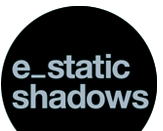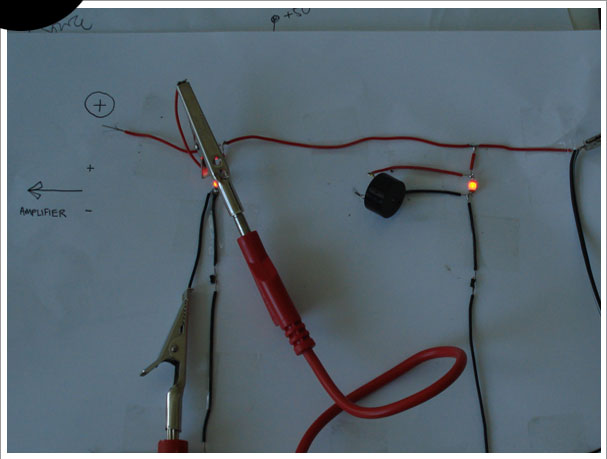

The project is hosted by:

The project is funded by:


The project is sponsored by:


The project is supported by:

![]()

Team
Principal Investigator
Prof. Janis Jefferies
Constance Howard Resource and Research Centre in Textiles / Goldsmiths Digital Studios, Goldsmiths College, University of London
Main Researcher
Dr. Zane Berzina
Constance Howard Resource and Research Centre in Textiles / Goldsmiths Digital Studios, Goldsmiths College, University of London
Architect
Jackson Tan
in square lab, London
Textile Engineering
Dr. Andreas Neudeck and the TITV team
TITV Greiz - The Institute for Specialised Textiles and Flexible Materials
Sound Engineering
Dr. Tim Blackwell
Computing Department, Goldsmiths College, University of London
Material Science
Dr. Natalie Stingelin-Stutzmann
Queen Mary University of London, Department of Materials
Janis Jefferies is Director of the Constance Howard Resource and Research Centre in Textiles (CHRRCT) and Artistic Director of Goldsmiths Digital Studios at Goldsmiths College, University of London, UK.
Janis Jefferies is recognised by her peers as one of the leading practitioner /theorists of her generation, through solo exhibitions of work (UK, Poland, America, Canada and Australia), conferences and professional seminars (e.g. UK, America, Iceland, Italy, Spain, Latvia, Estonia, Lithuania, Russia), and artist residencies at the Universities of Wollongong and Newcastle (Australia), visiting professorships at Art Institute of Chicago, and University of South Australia, curatorial work (14 since 1979), 42 journal publications, 10 catalogue essays for artists of international standing, 2 edited books and several chapter contributions to anthologies distributed by Manchester and Edinburgh University Presses, Telos Art Publishing, Berg Publishers, and the School of the Art Institute of Chicago, USA. She was one of the founding editors for Berg publishers of 'Textile: The Journal of Cloth and Culture' and has edited several special issues.
Recent publications include chapters in, The Object of Labor (School of the Art Institute of Chicago/MIT Press, 2007), Textiles as Fine art (Black Dog Publishing, UK, 2008), Touch in Museums, (Berg Publishing, 2008) and Extra/Ordinary Craft (Duke University Press, USA, 2009).
She holds A Crafts Council UK Curating Award, Spark plug which is looking at the relationship between Maths and Textiles.
Relevant links:
www.goldsmiths.ac.uk/constance-howard/
www.goldsmiths.ac.uk/gds/people.php
Originally from Latvia, artist, designer and researcher Zane Berzina works on interdisciplinary projects across the fields of science, technology and the arts. Her practice and research evolves around responsive and interactive textiles, new textile materials, processes and technologies as well as biomimetic practices. In 2005 Zane accomplished a practice-based Ph.D. 'Skin Stories : Charting and Mapping the Skin' at the London College of Fashion, University of the Arts London using analogies of human skin in relation to her textile practice. She developed a new transferable methodological model that other designers working at interface between biology, material science, technology and textile design can consult and adapt for their work.
Zane Berzina is exhibiting extensively around Europe and is actively involved in the cultural debate across design, art, technology and creativity. Her practice and research contribute to cross-disciplinary activities in science, art and design and demonstrate how they might influence the cultural environment. She is collaborating with scientists, architects and various companies in order to realise her cross-disciplinary projects. Research collaborations include TITV - Textile Research Institute Greiz in Thueringen, Germany; Fraunhofer Institute, Division for Synthesis Technology and Polymer Engineering, Germany; Freie Universitaet Berlin, Institute for Biology and Zoology, Germany; Kramm & Strigl Architects in Germany and Textile company 'Creation Baumann' in Langenthal, Switzerland.
Zane Berzina is co-founder and Artistic Director of the 'E-Text and Textiles' project in Riga (Latvia), Research Fellow at the Constance Howard Resource and Research Centre in Textiles (CHRRCT) and an Associate Member of Goldsmiths Digital Studios, University of London. Recently she took up a Professorship at the Kunsthochschule Berlin-Weissensee, Germany.
Relevant links:
www.zaneberzina.com
www.goldsmiths.ac.uk/constance-howard
www.goldsmiths.ac.uk/gds/people.php
Peck Leong, Jackson Tan was born in 1978 in Singapore. After graduating with a Bachelor of Arts (Architecture) from the National University of Singapore in 2002, he started his internship with high profile Singapore architecture firm Arc Studio Architecture + Urbanism and is a member of the design team that won the first Singapore international public housing architecture competition. The project was subsequently exhibited in Venice Biennale and London's Truman Brewery. In 2003, Jackson moved to London and completed his Diploma in architecture with the Bartlett School of Architecture, University College London. During the two years with the Bartlett, he was an active member of the Bartlett Interactive Architecture Workshop (Unit 14) and was primarily interested in the role of electrostatic in relation to human and architecture. His work 'e-Static Panel' was exhibited at the Bartlett Architecture Machine exhibition and at the Summer Show where the unit was also awarded with the Opener's prize by Wolf Prix of Coop Himmelblau. In the summer of 2005, Jackson co-authored the paper "Interlacing Urban Fabric" with Thomas Kitazawa, Goldsmiths College and Sam Malcolm Strauss, Central Saint Martins, for the "Wearable Futures" conference held in University of Wales, UK. Jackson joined prominent British architectural firm Hopkins Architects in 2006 working on prestigious projects such as regeneration of Nottingham Trent University and the Cyprus Cultural Centre. In the same year, Jackson co-founded London-based architecture research unit insquarelab with Ernie Lew and Ernest Tsui; focusing primarily on the experimentation of time based architecture.
Relevant links:
Andreas Neudeck is responsible for fundamental and innovative research projects as Vice Head of the Department of Research and Development at TITV Greiz - The Institute for Specialised Textiles and Flexible Materials since 2006. He finished his Master of Education specialising in Secondary School Science and Mathematics after a 4 years study at the Pedagogical University in Halle (Saale) in 1984. In 1999 he received a DSc degree in Physical Chemistry at the Dresden University of Technology after his PhD at the Pedagogical University Halle (Saale) in 1989. The subject of his PhD focused on the understanding of electrochemical reactions and he obtained his DSc degree for his spectroelectrochemical studies on micro-structured electrodes. After several research stays abroad, including a three-month Invited Professorship post in Paris at the University Denis Diderot as well as a 1.5 years post at the Oxford University he moved back to Germany.
At the TITV Greiz Andreas Neudeck initiated the research development of galvanic metal deposition on textiles. The research team's joint efforts resulted in the development of the ELITEX ® yarn. For the E-Static Shadow project special textile structures were developed based on this highly conducting high-performance yarn.
Dr. Andreas Neudeck was responsible for the E-Static Shadows project from the side of TITV Greiz. Further important contributors tothe project were: Dr. Uwe Mohring, Dirk Zschenderlein, Christian Rotsch, Frank Thurner, Manuela Roth, Rudolf Breunung, Simone Baas, Heike Oschatz.
Relevant links:
Tim Blackwell is with the Department of Computing at Goldsmiths, University of London. He has degrees in physics, theoretical physics and computer science and has researched a wide range of subjects including quantum field theory, condensed matter theory, psychology, computer music, digital art and swarm intelligence.
He is an active musician and is well known for the application of swarms to improvised music. His Swarm Music system has been the subject of numerous articles, radio programmes and TV documentaries worldwide. He heads, with the composer Michael Young, the EPSRC Live Algorithms for Music (LAM) research network, an interdisciplinary network of 100+ musicians, engineers and computer scientists.
He has also developed Woven Sound, a technique for real-time generation of textile patterns from sound.
Relevant links:
www.goldsmiths.ac.uk/computing
www.goldsmiths.ac.uk/gds/people.php
Natalie Stingelin-Stutzmann studied Materials Science and Engineering in the Department of Materials at the Swiss Federal Institute of Technology in Zurich (ETHZ), Switzerland. She obtained the degree of Engineer in Materials Science in 1997, and in 2001 completed her doctoral studies in the Polymer Technology Group, for which she was awarded the ETH Medal. From 2001 - 2003, she was a post-doctoral fellow in the Cavendish Laboratory at the University of Cambridge, supported by a grant from the Swiss National Science Foundation; and in the period of 2003 - 2005 she conducted research on organic field-effect transistors at the Philips Research Laboratories, Eindhoven, The Netherlands, funded by the Swiss Federal Office for Education and Science. From 2005 - 2008, Natalie Stingelin built up her own group, first in the position of Research Fellow, then Lecturer of Materials at Queen Mary, University of London. Very recently, Natalie Stingelin was offered a Staff Position at the Department of Materials, Imperial College London (ICL), where she started in January 2009 as Lecturer of Organic Functional Materials.
Her research is supported by grants from EPSRC, the Royal Society, the Leverhulme Trust, the European Commission, The Dutch Polymer Institute and industrial partners. She furthermore benefits from national and international collaborators at the Technical University of Eindhoven, The Netherlands; ETH Zurich, Switzerland; Technion, Israel; Georgia Institute of Technology and the National Institute of Standards, USA. Her current research interests include organic electronics, multifunctional inorganic/organic hybrids and smart, advanced optical systems.